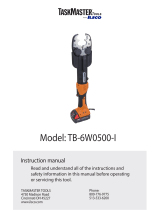
2
1.
2. Before using the battery pack and charger, read
this operator's manual, your tool's operator's
manual, and all labels on the battery pack,
charger and tool.
5.
6. Avoid dangerous environments. Do not
charge
battery pack in rain, snow, damp or wet locations.
Do not use battery pack or charger in the presence
of explosive atmospheres (gaseous fumes,
dust
or materials) because sparks
may
be
generated when inserting or removingbattery
pack, possibly causing
7. Charge in a well ventilated area. Do not block
charger vents. Keep them clear to allow proper
ventilation. Do not allow smoking or open
near a charging battery pack. Vented gases may
explode.
8. Maintain charger cord. When unplugging charger,
pull plug rather than cord. Never carry charger by
its cord. Keep cord from heat, oil and sharp edges.
Make sure cord will not be stepped on, tripped over
or subjected to damage or stress. Do not use char-
ger with damaged cord or plug. Have a damaged
charger replaced immediately.
9. Avoid using an extension cord when possible.
Make sure that the extension cord is in good electri-
cal condition.
Use only recommended attachments.
11. Unplug charger and remove battery packs when
not in use.
12.
14. Do not crush, drop, or damage battery pack.
Always securely contain battery packs during
transport. Do not use a battery pack that has
received a sharp blow, been dropped, run over, or
damaged in any way (e.g., pierced with a nail, hit
with a hammer, stepped on, in a vehicle accident).
15.
16.
17. Do not short circuit. A short-circuited battery
pack may cause personal injury, and product
damage. A battery pack will short circuit if a metal
object makes a connection between the positive
and negative contacts on the battery pack. Do
not place a battery pack near anything that may
cause a short circuit, such as coins, keys or nails
in your pocket.
18.
Corrosive or conductive such as seawater,
certain industrial chemicals, and bleach or bleach
containing products, etc., can cause a short circuit.
19. Battery packs marked as Resistant
are suit-
able for environments where incidental contact or
exposure to oils, greases, and solvents can occur.
These packs are not resistant to acids or other cor-
rosive chemicals. Never immerse or allow to
penetrate the battery pack.
20.
21.
IMPORTANT SAFETY INSTRUCTIONS
- SAVE THESE INSTRUCTIONS -
READ AND UNDERSTAND ALL INSTRUCTIONS. Failure to follow all
instructions listed below, may result in electric shock, and/or serious personal injury.
SAVE THESE INSTRUCTIONS - These
instructions contains important safety and
operating instructions for this MILWAUKEE®
Li-Ion charger and MILWAUKEE® Li-Ion
battery packs.
Use MILWAUKEE® Li-Ion
battery packs only on
recommended MILWAUKEE® Li-Ion
products. Do not use counterfeit, aftermarket,
or "knockoff" batteries or chargers. Do not wire
a battery pack to a power supply plug or car
cigarette lighter.
Always unplug charger before cleaning or
maintenance. Use a residual current device
(RCD) protected supply to reduce shock
hazards.
Do not disassemble battery pack or charger.
If it is damaged, take it to a MILWAUKEE®
service facility.
Battery chemicals cause serious burns.
Never allow contact with skin, eyes, or mouth. If
a damaged battery pack leaks battery
chemicals, use rubber or neoprene gloves to
dispose of it. If skin is exposed to battery fluids,
wash with soap and water and rinse with
vinegar. If eyes are exposed to battery
chemicals, immediately flush with water for 20
minutes and seek medical attention. Remove
and dispose of contaminated clothing.
Store your battery pack and charger in a
cool, dry place. Do not store battery pack where
temperatures may exceed 50°C (120°F) such
as in direct sunlight, a vehicle, or metal building
during the summer.
Always use a side handle when using a
battery pack 6.0 Ah or above; the output
torque of some tools may increase. If your
drill/driver did not come with a side handle, visit
milwaukeetool.com.au/milwaukeetool.co.nz for
the appropriate accessory handle.
ADDITIONAL BATTERY SAFETY RULES
WARNING
WARNING
To reduce the risk of fire, personal
injury, and product damage due to
a short circuit, never immerse your tool, battery
pack or charger in fluid or allow a fluid to flow inside
them. Corrosive or conductive fluids, such as
seawater, certain industrial chemicals, and bleach
or bleach-containing products, etc., can cause a
short circuit.
Do not charge non-rechargeable
batteries.
3.
4.
This appliance is not intended for use by
persons (including children) with reduced
physical, sensory or mental capabilities, or
lack of experience and knowledge, unless
they have been given supervision or
instruction concerning use of the appliance
by a person responsible for their safety.
Children should be supervised to ensure
that they do not play with the appliance.
10.
13. Do not burn or incinerate batteries. Batteries
may explode. Toxic fumes and materials are cre-
ated when batteries are burned.








